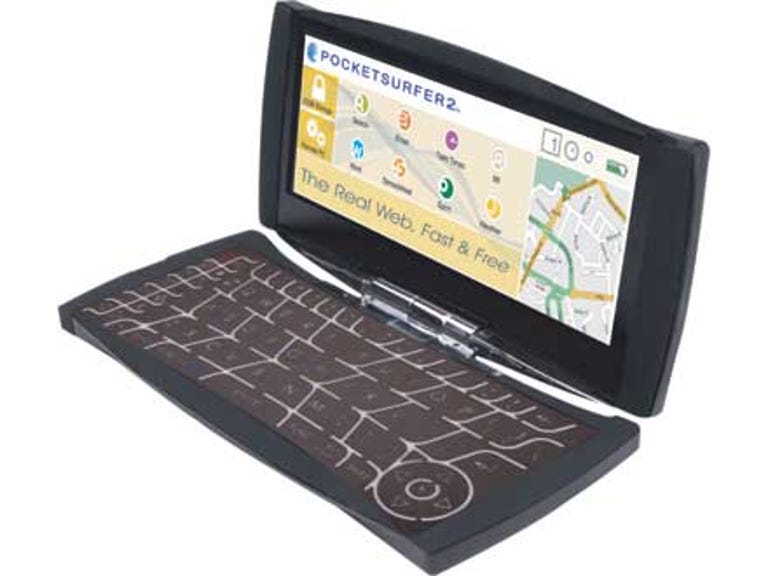 Why You Can Trust CNET
Why You Can Trust CNET PocketSurfer2 review: PocketSurfer 2
Want free Web surfing on an easy to use and speedy device? Then the PocketSurfer 2 is exactly not what you're looking for.
Design
There must be something about living in a really cold country (such as, say, Canada) that prompts geeks to fiddle around with data compression techniques. We're not just throwing that theory out randomly here; the world's best known compression company (when it comes to email), RIM, is based in Canada. Datawind, makers of the PocketSurfer 2, are similarly of a far North American bent, but their particular gig isn't optimal email delivery, but web page compression. Their entry product into the Australian market is the PocketSurfer 2, a slim fold out web terminal that fits into your pocket.
The Good
The Bad
The Bottom Line
With its lid closed, the PocketSurfer2 somewhat resembles the newer, slimmer Playstation Portable console. It measures in at 15.24x7.56x1.52cm and weighs a scant 174 grams. Opening it up reveals an entirely flat keyboard with directional controls in the bottom right hand corner. Aside from a mini-USB terminal, hidden under a rubber flap -- presumably as something has to keep the snow out -- that's your lot for physical details.
Features
The big hook with the AU$399 PocketSurfer 2 is the offer of free Internet access. How have Datawind managed this particular trick?
Basically, they've taken a slow and cheap data technology -- GPRS -- and applied compression techniques to web pages to make them fit the PocketSurfer 2's display screen. Datawind's claim is that it can render web pages this way in under 7 seconds, which is faster than we'd expect out of a paltry GPRS connection -- especially when you consider that, like mail going through a Blackberry, data going to the PocketSurfer 2 has to route its way via Canada before it's presented to your eyes.
The PocketSurfer also includes an embedded email client and GPS functionality. The display is relatively low resolution at only 640x240. Datawind claims the battery life as being good for around 5 hours of surfing time or five days worth of standby time.
Performance
So far, so good -- we love the idea of a free Web service, especially in the data-constrained Australian broadband market. There's only one major fly in the ointment here -- actually using the PocketSurfer 2 is an exercise in testing your patience, or alternatively, your frustration levels.
Firstly, there's the keyboard. It's entirely flat, rather unresponsive, and uses a number of weird key conventions for Web surfing that take quite a while to become native responses. Then there's the low resolution screen, which, to put it politely, is going to send a lot of work to your optometrist if you stare at it for too long. Clearly, part of the speed caching that Datawind does is to strip out a lot of colour that the PocketSurfer 2 can't handle. Nice in theory, but the effect is to deliver web pages that look washed out, and text that is often far too small and simultaneously blurry to actually read.
Then there's the speed issue. Yes, the PocketSurfer 2 is quicker than you might expect a GPRS connection to be. It's just that unless you're surfing very popular pages, they've still got to be cached, and you can generally forget about getting sites in the claimed seven second time frame. Even when you do, we often found the PocketSurfer 2 -cheating", by only grabbing and rendering the first couple of screen depth's worth of content. Scroll down too far, and you've got to do the whole cache waiting dance again.
Finally, there's the issue of the definition of -free". Firstly, it's only -free" for the first year. Second up, it's only -free" for up to twenty hours per month. We can't imagine staring at the PocketSurfer 2 for twenty hours without starting to go blind, but even so, if you do want or need lots of access, you'll have to pay for it -- currently AU$9.99 for 50 hours or AU$19.99 for unlimited use. After the first year, the basic twenty hours package will cost you no more than AU$50/year. It's not that these are unreasonable basic data charges per se; it's just that there's a distance between what you might expect for -free" and what you actually get, and it's worth knowing that upfront.
Ultimately, the idea behind the PocketSurfer 2 is much better than the implementation. It works well enough in a basic GPRS sense, but the terrible screen, multi-page loading times and not-exactly-free structure make it a hard sell, especially as it's such a one-trick pony. For not much more money you could buy a much more capable Eee PC, or even a budget brand-name notebook PC.



